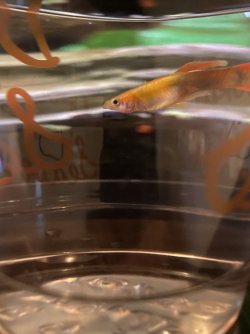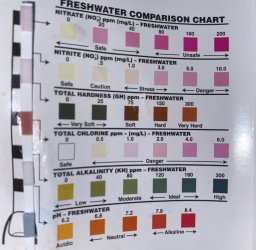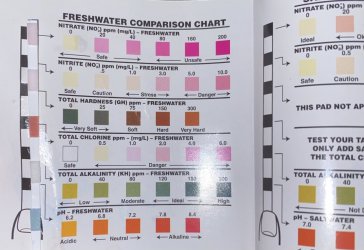Any reading above zero is bad for nitrite as well. Test every day, and if nitrite is above zero, do a water change. It is impossible to say do a water change every so many days as it all depends on the reading in the tank water.
-
Guest, the Tank of the Year contest is underway!
💧 Which tank will win? 👉 View the entries and vote now!!
You are using an out of date browser. It may not display this or other websites correctly.
You should upgrade or use an alternative browser.
You should upgrade or use an alternative browser.
How do I lower my nitrites
- Thread starter Bettaguy08
- Start date
Bruce Leyland-Jones
Fish Aficionado
So this was a hypothetical question;Luckily I really never have had ammonia issues
Like 2.0 ammonia, would I have to do daily water changes for that?
Sadly, the reality is that you are having 'ammonia issues', which is why your nitrites are so high.
The good news is that you appear to have effective ammonia-munching bacteria, that seem to be taking that ammonia and turning it into something else.
The bad news is that 'something else' is nitrite, which is also toxic.
Changing the water will remove some of these and will dilute the rest, but it's still toxic and you're having to keep on with the water changes until your nitrite-munching bacteria is up to the job. This might take a while.
This is why those of us who appreciate the Power of Plants promote them, because growing plants are great at munching ammonia and nitrites and nitrates. (While they do this, they also produce oxygen, etc.).s
Your Java Fern, whilst very nice to look at, is a very slow growing plant, so will not help with the munching of nitrogen compounds. This is why I'm recommending pondweed and floaters. These are fast growing and can be just plonked in the tank.
NWC
New Member
Might be a silly question but did you de-chlorinate the water on the large water change?
Do a 75% water change and gravel clean the substrate any day you have an ammonia or nitrite reading above 0ppm, or a nitrate reading above 20ppm.One last question, so should I do like 3-4 water changes a week till nitrites stay at 0 for a week? would that be good? And how much water should I change.
Make sure any new water is free of chlorine/ chloramine before it's added to the tank.
As a guide, if say your nitrite is 10 ppm and you WC 75% of the water, you rnitrites would drop down to 2.5 ppm . If you then did another 75% water change it would drop down to 0.625 ppm. s
Last edited:
Bettaguy08
Fish Crazy
Yes alwaysMight be a silly question but did you de-chlorinate the water on the large water change?
Be sure you shake shake shake those reagent bottles very strongly. Bang them on a table to further mix them.
Last edited:
Bettaguy08
Fish Crazy
Well I was doing a water change right now to get the nitrites out and another guppy is gone, I only have 3 now and one of them looks like it is about to pass aswell, all of my other fish look fine though, which is my otocinclus and baby betta. Here is the guppy that is looking weird, what should I do, can it be saved or is it already to late? It’s breathing super quick, edit: I just found another guppy that is starting to look weird and floating at the top a lot aswell.
Attachments
Last edited:
Bettaguy08
Fish Crazy
Can anyone tell me if I still have nitrites? I did a %75 water change, tested my water and there was still nitrites so I did another %40 water change and I don’t think I have nitrites but I can’t tell, here is the picture of the results can anyone tell if I have nitrites?
Attachments
where is a pic of your test tube?
Bettaguy08
Fish Crazy
I do not have test tubes, I just put the test strips in the water for a minute then let it sit out of the water for like a minutewhere is a pic of your test tube?
Last edited:
I'm not sure if there is salt in the water but if there isn't, you can add some salt.
You can add rock salt (often sold as aquarium salt) or swimming pool salt to the aquarium at the dose rate of 1 heaped tablespoon per 20 litres of water. If there is no improvement after 48 hours you can double that dose rate so there is 2 heaped tablespoons of salt per 20 litres.
If you only have livebearers (guppies, platies, swordtails, mollies), goldfish or rainbowfish in the tank you can double that dose rate, so you would add 2 heaped tablespoons per 20 litres and if there is no improvement after 48 hours, then increase it so there is a total of 4 heaped tablespoons of salt per 20 litres.
Keep the salt level like this for at least 2 weeks but no longer than 4 weeks otherwise kidney damage can occur. Kidney damage is more likely to occur in fish from soft water (tetras, Corydoras, angelfish, Bettas & gouramis, loaches) that are exposed to high levels of salt for an extended period of time, and is not an issue with livebearers, rainbowfish or other salt tolerant species.
The salt will not affect the beneficial filter bacteria but the higher dose rate (4 heaped tablespoons per 20 litres) will affect some plants and some snails. The lower dose rate (1-2 heaped tablespoons per 20 litres) will not affect fish, plants, shrimp or snails.
After you use salt and the fish have recovered, you do a 10% water change each day for a week using only fresh water that has been dechlorinated. Then do a 20% water change each day for a week. Then you can do bigger water changes after that. This dilutes the salt out of the tank slowly so it doesn't harm the fish.
If/ when you do water changes while using salt, you need to treat the new water with salt before adding it to the tank. This will keep the salt level stable in the tank and minimise stress on the fish.
You can add rock salt (often sold as aquarium salt) or swimming pool salt to the aquarium at the dose rate of 1 heaped tablespoon per 20 litres of water. If there is no improvement after 48 hours you can double that dose rate so there is 2 heaped tablespoons of salt per 20 litres.
If you only have livebearers (guppies, platies, swordtails, mollies), goldfish or rainbowfish in the tank you can double that dose rate, so you would add 2 heaped tablespoons per 20 litres and if there is no improvement after 48 hours, then increase it so there is a total of 4 heaped tablespoons of salt per 20 litres.
Keep the salt level like this for at least 2 weeks but no longer than 4 weeks otherwise kidney damage can occur. Kidney damage is more likely to occur in fish from soft water (tetras, Corydoras, angelfish, Bettas & gouramis, loaches) that are exposed to high levels of salt for an extended period of time, and is not an issue with livebearers, rainbowfish or other salt tolerant species.
The salt will not affect the beneficial filter bacteria but the higher dose rate (4 heaped tablespoons per 20 litres) will affect some plants and some snails. The lower dose rate (1-2 heaped tablespoons per 20 litres) will not affect fish, plants, shrimp or snails.
After you use salt and the fish have recovered, you do a 10% water change each day for a week using only fresh water that has been dechlorinated. Then do a 20% water change each day for a week. Then you can do bigger water changes after that. This dilutes the salt out of the tank slowly so it doesn't harm the fish.
If/ when you do water changes while using salt, you need to treat the new water with salt before adding it to the tank. This will keep the salt level stable in the tank and minimise stress on the fish.
Your test strip shows high chlorine. An api test kit is generally considered more accurate than test strips.p
What brand are u using for dechlorinator?
What brand are u using for dechlorinator?
Last edited:
Bettaguy08
Fish Crazy
My chlorine is the 4th one, which is the one that is completely white, my decloernator brand is api stress coat + and quick startYour test strip shows high chlorine. An api test kit is generally considered more accurate than test strips.p
What brand are u using for dechlorinator?
Bettaguy08
Fish Crazy
OkI'm not sure if there is salt in the water but if there isn't, you can add some salt.
You can add rock salt (often sold as aquarium salt) or swimming pool salt to the aquarium at the dose rate of 1 heaped tablespoon per 20 litres of water. If there is no improvement after 48 hours you can double that dose rate so there is 2 heaped tablespoons of salt per 20 litres.
If you only have livebearers (guppies, platies, swordtails, mollies), goldfish or rainbowfish in the tank you can double that dose rate, so you would add 2 heaped tablespoons per 20 litres and if there is no improvement after 48 hours, then increase it so there is a total of 4 heaped tablespoons of salt per 20 litres.
Keep the salt level like this for at least 2 weeks but no longer than 4 weeks otherwise kidney damage can occur. Kidney damage is more likely to occur in fish from soft water (tetras, Corydoras, angelfish, Bettas & gouramis, loaches) that are exposed to high levels of salt for an extended period of time, and is not an issue with livebearers, rainbowfish or other salt tolerant species.
The salt will not affect the beneficial filter bacteria but the higher dose rate (4 heaped tablespoons per 20 litres) will affect some plants and some snails. The lower dose rate (1-2 heaped tablespoons per 20 litres) will not affect fish, plants, shrimp or snails.
After you use salt and the fish have recovered, you do a 10% water change each day for a week using only fresh water that has been dechlorinated. Then do a 20% water change each day for a week. Then you can do bigger water changes after that. This dilutes the salt out of the tank slowly so it doesn't harm the fish.
If/ when you do water changes while using salt, you need to treat the new water with salt before adding it to the tank. This will keep the salt level stable in the tank and minimise stress on the fish.
Similar threads
- Replies
- 26
- Views
- 1K
- Replies
- 19
- Views
- 2K
Most reactions
-
 337
337 -
 143
143 -
 141
141 -
 137
137 -
 133
133 -
 129
129 -
 123
123 -
 109
109 -
 73
73 -
 73
73 -
 66
66 -
 61
61 -
 59
59 -
 53
53 -
F
49




